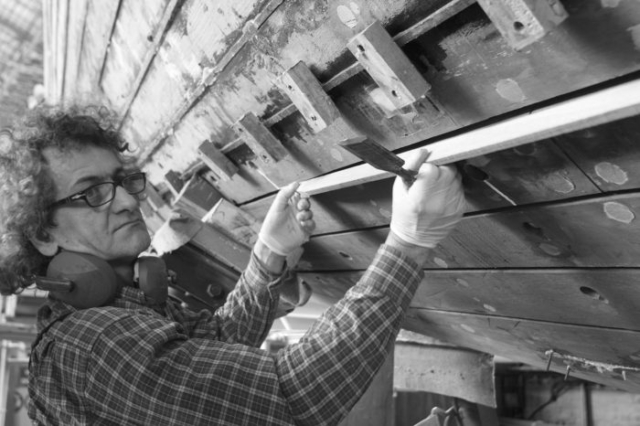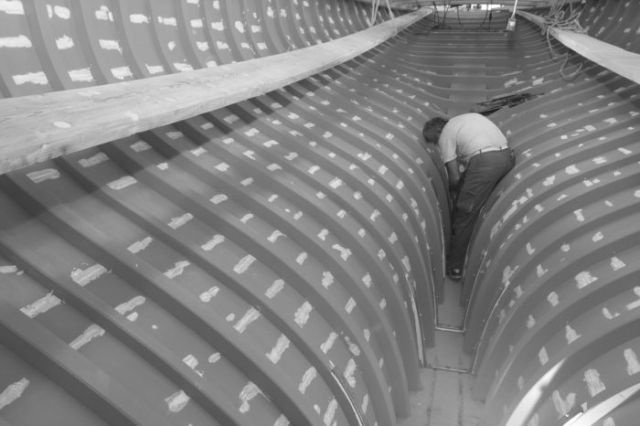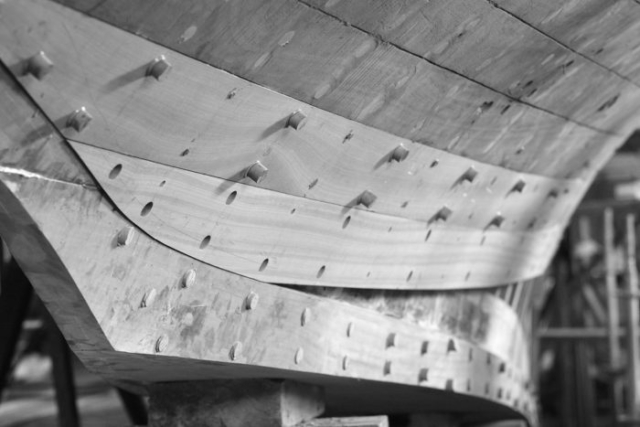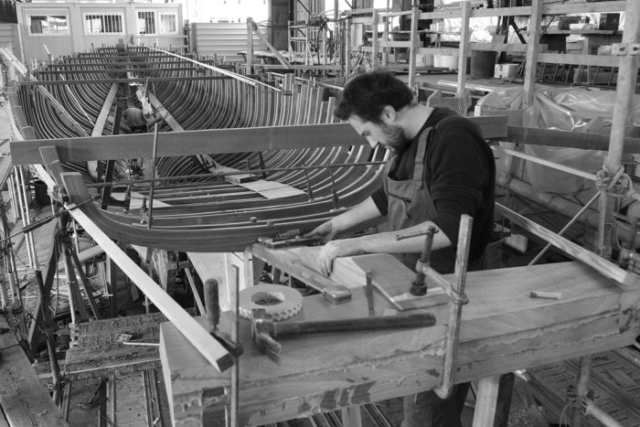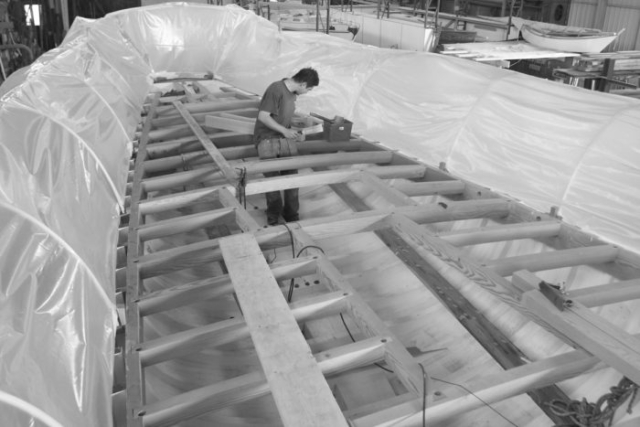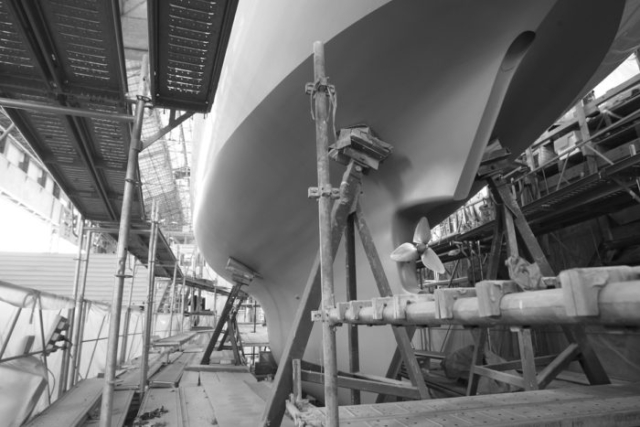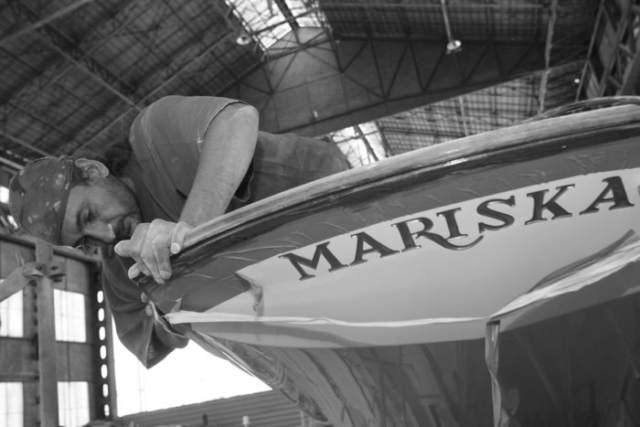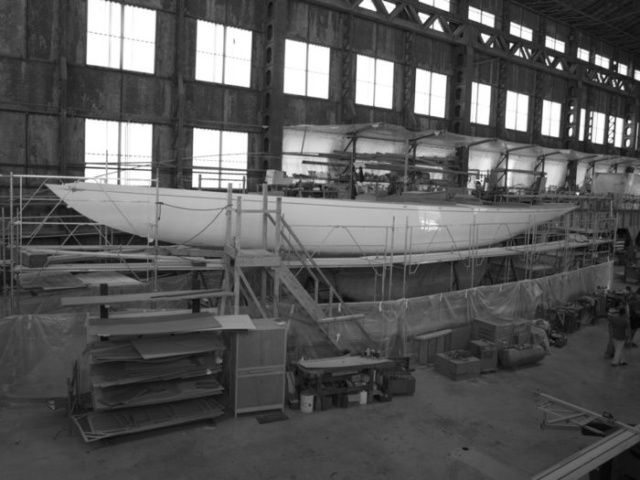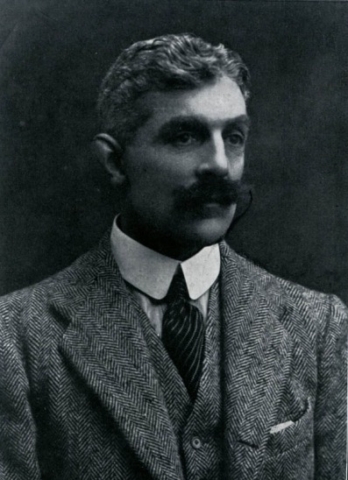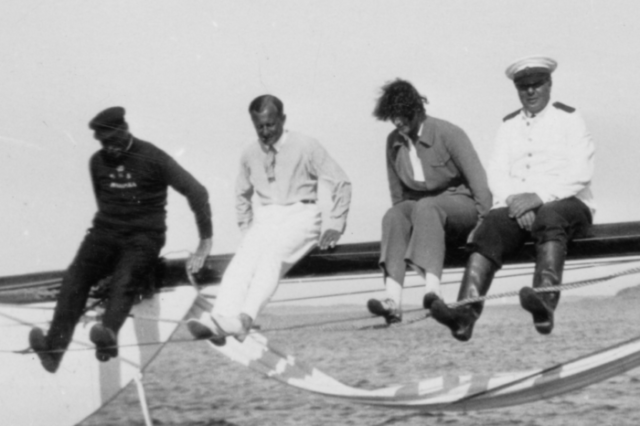
Sail Number: D1
Type: 15 Metre Class
LOA: 90’6″ / 27.60m – LOD: 76’9″ / 23.40m – Beam: 13’9″ / 4.20m – Draft: 9’0” / 2.75m – Building Number: 553 – Designer: William Fife III – Original Owner: A K Stothert – Current Owner: Christian Niels – Year Launched: 1908 – Built By: William Fife & Son – Hull Material: Hull steel/wood composite – Hull Displacement: 34 tonnes – Sail Area: 1355.75 m2 – Location: Marine Traffic – Flag: United Kingdom (GB) – Club: SNST (The Société Nautique de Saint-Tropez)
The History of the Class
1908 Mariska, D1, Fife
Mariska was the second 15-Metre Class yacht to be designed and built by William Fife, one year after the launch of Shinna in 1907. She was commissioned by A.K. Stothert, one of the most prominent figures in yachting in this era, who had been collecting racing yachts and notching up victories ever since 1894.

The International Rule which created the 15s was devised by a group of the leading European yacht designers and other interested parties in 1906. They were wrestling with an old problem that had been clearly expressed in 1892 in a joint letter to the YRA from leading British yacht designers of the age, including Fife, Watson & Nicholson.
A desire to create a yacht with reasonable accommodation and to avoid short-lived “freaks”, fit only for racing, was also central to the International Rule. As a result, the rule was in two parts; a “scantling” rule which fixed minimum sizes and weights for all the structural elements of the hull, and a rating rule to measure the shape of the yachts and their rigs on a agreed basis.
The Rule also included minimum standards for accommodation; in the case of the 15s, intended that the owner could live on board for the season in reasonable comfort. The rule required a “least height of cabin” from sole to the underside of the deck (ignoring deck beams) of 6.23ft (1.90m), a “least breath of floor” from hull side to hull side of 4.65ft (1.40m), at least four bulkheads 0.59″ (15mm) thick, four sleeping berths and five sleeping “places” (for the crew, or some of them); and other details about lockers and toilets. There were also limits on crew numbers; only 14 people were allowed on board a 15 Meter during a race. At present there is no restriction on the number of crew per yacht.
1908 Mariska, D1, Fife
Mariska was the second 15-Metre Class yacht to be designed and built by William Fife, one year after the launch of Shinna in 1907. She was commissioned by A.K. Stothert, one of the most prominent figures in yachting in this era, who had been collecting racing yachts and notching up victories ever since 1894.

The English racing season lasted from the end of May to the end of September. In 1908, after modest beginnings at Port Victoria on the Thames, Mariska was one of two 15-Metre Class yachts taken to Scotland at the end of June to race on the Clyde. Carrying 400 square feet of canvas more than the 52-foot Britomart, she won easily in light airs. On 28 and 29 July she was to be found racing in Le Havre, where she completed the 21 miles of the first race in 2 hours, 34 minutes and 55 seconds. The next day saw her bowing down before Shinna. It was a spectacle of great beauty, as the two 15-Metre Class yachts had chosen to carry the same canvas as the 23-Metre yachts: mainsail, sharply angled topsail and small flying jib. Mariska won the Le Havre regatta with a first and a second place.
At the start of March 1908 Philippe de Vilmorin, a seed merchant and Commodore of the Cannes Regatta Association, christened his Anémone II, the 15-Metre Class yacht designed for him by the French naval architect C.M. Chevreux. The same year King Alfonso XIII of Spain took delivery of Hispania, designed by Fife but built in Spain by the Carraso yard in Karpard, while the King’s friend the Duke of Medinacelli acquired her sister ship Tuiga. The 15-Metre Class yachts were all the rage in Spain. Encarnita, designed by the French naval architect Guédon, was also launched, while Shinna was sold into Spanish hands by J.R. Payne, for whom Fife was already building Vanity. Meanwhile Alfred Mylne was designing Ostara…
Hispania, Tuiga and Anémone II were brought by freighter to the French Channel coast to sail across to race on the Thames and at Cowes. While Tuiga took four days to reach England due to bad weather, meanwhile on Wednesday 4 August Mariska won the 15-Metre Class in the Cowes International Cup.
In 1909, two 19-Metre Class yachts under construction at Fife’s yard. The second of these was to be christened Mariquita. She was commissioned by A.K. Stothert, the owner of Mariska, and sold in 1911 to Capt. the Hon. F.E. Guest, when her home port became Glasgow. A year later, Mariska passed into the hands of J.W. Cook, who sold her on in 1913 to Carl Krüger, a German living in Gothenburg in Sweden, where the yacht was based from 1914. In 1923 she was bought by Carl Mathiessen, who lived in Stockholm; he brought the boat there and converted her into a yawl. This marked the end of Mariska’s racing career, which had lasted from 1908 to 1923. A 1933 entry in Lloyd’s Register states that Mariska had been “built in accordance with 15–Metre Class rules”. She was now a cruising yacht, in the hands of owners who saved her from the vicissitudes of World War II.
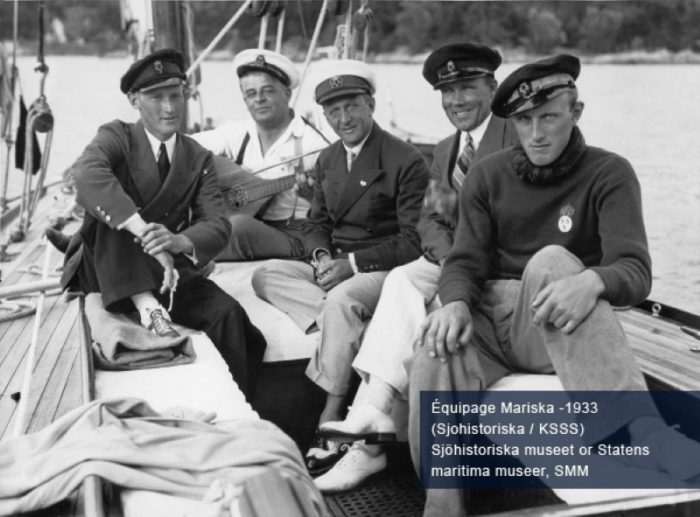
The person who cared most for the yacht was perhaps Mr De Jong, her first Dutch owner, who bought her in 1983 and sold her in 2001 to another Dutchman, Edgar Holtbach. By this time Mariska was rigged as a ketch; the whole of her stern had been amputated, and the remaining horn timber butchered to take an enormous propeller cage. However, as Mr De Jong reports, “She was an excellent boat for family cruising, very safe, and we sailed her in the Baltic Sea and North Sea every summer. I have nothing but good memories of this boat, which remains dear to my heart. But in the end she needed major repair work that I was not able to undertake, so I sold her.”
Mariska’s new owner Edgar Holtbach was well aware that he was in possession of a real rarity; all the more so because classic yachting was now all the rage. He intended to do well out of selling the yacht. But his asking price was far too high because much as everyone wished to own Mariska, the extent of the restoration work required on her meant that the purchase price had to be reasonable. After a few years of prospecting, everything went quiet; then suddenly the deal was closed very quickly. There were many yachtsmen who dearly wanted this boat in England and in Spain. But it was a Swiss property promoter with an obsessive passion for classic yachts who became the owner of the most highly-coveted yacht of the moment. Mariska’s restoration is being undertaken in the south of France, at La Ciotat, in the hands of an entirely French team, under the direction of the Cannes naval architects Jacques Faroux and his son Nicolas Faroux. Afterwards the yacht will come to the Mediterranean to form part of the quartet of Fife-designed 15-Metre Class yachts currently sailing there, alongside Hispania, Tuiga and The Lady Anne.
Mariska’s hull was built in the composite materials of the period, with ribs of mild steel and white elm on metal floor plates. Since no-one in Europe still had the necessary equipment or the expertise to work mild steel, it was decided to make the new ribs in laminated wood. It was apparent that the planking had been replaced at least twice at different times, because iroko and older mahogany were found in the upper works and 59 linear metres of pitch pine at the level of the garboards; these, they are almost certain, date back to the yacht’s construction, as their pegging is original. The floor plates between the steel ribs were simply made of sheet metal, with just a curved piece of steel at the foot of the wooden ribs.
The skins are 45 mm thick, while the planking over the whole hull varies in thickness from 32 to 45 mm. This is quite considerable when one adds back on the millimetres planed and sanded off every time the hull was maintained. The replacement planks that have been used are 42 mm thick and around 5 metres long, while the original ones were 7 metres long.
Was it done so that the yacht could moor hard up against the quay stern on, or because the long horn timbers were rotten and no-one could face undertaking the necessary repairs? For whatever reason, the hull was cut off at rib no. 63 of a total of 72 ribs, and the operation took away three metres of deck at a stroke! But that is not all: a rough hole was also cut through the sternpost for a large propeller cage. And because the wood was rotting, it was reinforced with a strip of oak at the same time. No-one has been able to identify the glue used, which would have made it possible to date this rough and ready repair. In any case it is not resorcine, the glue most commonly used, and so was done before the war. It is evidence that shipwrights were already in the habit of using glue in boat building at this time.
Another major modification was found when the boat was dismantled: the ballast, just a 40 mm thick sheet metal shell packed with various materials coated in a layer of cement, was not original. The lead for the new ballast comes from the keel of one of the yachts in the Alinghi team built for the last America’s Cup in Valencia.
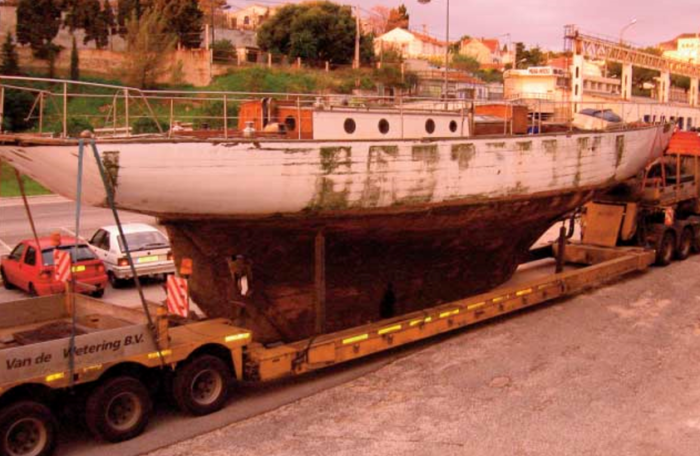
By now Mariska’s deck plan no longer bore the remotest resemblance to the one designed by William Fife. It had been completely altered and topped with a very large deck house measuring 0.55 metres high, 2.5 metres wide and 5 metres long. The original beams were made of pitch pine, but when the boat arrived at La Ciotat, the decks were simply covered over with plywood. As this was not joined to the gunwales, water had poured in and rotted the ribs. All of the rig had completely disappeared of course: all that remained were the two mast steps from the yacht’s incarnation as a ketch.
It was unanimously decided that everyone would do their utmost to preserve as many parts of the original as possible, starting with the oak keel. The stem, on the other hand, had to be replaced. Its upper section was rotten, as was the area beneath the mast step. As for the deck beams, those that were still mostly sound were reused with their rotten ends removed. The new beams around the foot of the mast are made from Oregon pine. All the spars, by Gilbert Pasqui, are made out of spruce except for the lower mast, which is in Oregon pine. This choice is justified by the fact that the latter’s greater density makes it much harder and more rigid than spruce.
The plywood ribs were made entirely at the yard in sipo, a type of African mahogany, 25 cubic metres of which arrived at the yard in billets. That may sound an enormous quantity of wood, but a lot – almost 80% – is lost due to the curved shape of the ribs. The making of these was a colossal task that took many long weeks. All of the hull pegging was replaced with pegs made of stainless steel: “We would have liked to replace them all with bronze pegs like the original, but it proved impossible to find a manufacturer” say the yard. “What is more, Mariska’s already had all stainless steel pegs when she arrived here.”
When it came to waterproofing the planking, splining was favoured over caulking. This method involves the insertion of wooden strips or splines which are glued in place between the planks. The splines, like the planks, are made of mahogany above the waterline and iroko below, as are the caps that conceal the screw heads. Then all that remains to be done is to sand off anything that stands proud….. Meanwhile other yard staff are busy inside the yacht positioning the new floor plates of stainless steel, a material widely used as soon as it became available to replace mild steel, which corroded fast. Twenty of the floor plates are made of flat iron, the others sheet stainless steel, bolted onto the ribs and skins. Finally the transversal plates that give the hull rigidity are made of sheet stainless steel, pierced with round holes.
The deck covering is made by the usual method of laying teak laths over plywood, which ensures that it is watertight. The deckhouse is made of mahogany and the sails will be hoisted on blocks, as there are no winches on board.
Such are the secrets of Mariska’s restoration. The next steps will be the laying of the deck covering and installation of the skylights and the interior technical fittings, the pipework and the wiring, before the interior is fitted out with the furniture. It will be a light and airy interior, with the panelling and deckheads painted in Boston white. There will be two shower rooms midships (one for the crew and one for the owner), and ample headroom to suit Mariska’s tall owner. The saloon will be in the centre. It will all be very classic, and very close to the original……
Architects Jacques and Nicolas Faroux: “This is a Restoration!”
Jacques Faroux and his son Nicolas, naval architects from Cannes, are specialists in the Metre Class yachts. They have restored several 8 and 6-Metre Class yachts besides being entrusted with the restoration of the 12-Metre Class France 3 and since then, all of the Metre Class yachts based in the Mediterranean have passed through their hands. It was only natural that they should be brought into the project, Marc Pajot having discovered a long time ago that they had some ten mast plans and several refits on the go.
“Mariska was in a fragile state. She had been repeatedly modified and badly restored at different periods. Proof of this is to be found in her planking, which is in teak, mahogany and pine. But this is a restoration and not a rebuild, as we have retained as many recoverable parts as possible. We even wanted to keep the old rudder, which is obviously original, but this was not to be. Still we kept the bronze fittings off it, and used it as a template so that the new one was the same. The boat’s draught had been greatly reduced, so we restored her keel to its original depth. But our main concern, with the owner’s agreement, has been to bring her back to compliance with 15-Metre Class rules. One century on, not much has changed. Of course we now have the use of some modern materials that were not known at the time when she was built, but one has to apply a certain code of ethics and respect the boat. The hull will be a bit stiffer, but the owner wants a safer yacht which is stiff under canvas, and the performance of the Dacron sails compared to the original cotton sails will largely compensate for the increased hull stiffness. We have designed a rig which is practically identical to the original rig. As for the difference between the original measurement rules and the CIM rules, the latter oblige us to take account of aesthetic factors which protect the yacht’s classic appearance but do not take account of performance, which is a heresy….”
Restoration
Mariska’s incredibly comprehensive restoration ran from 2007 to 2009 and totaled 25,000 man hours. It was decided to stick to the 15m Class regulations and as closely as possible to the original design of William Fife III. A significant point is that this project was intentionally a restoration and NOT a reconstruction.
Key Companies
Shipyard: Chantiers Réunis Méditerranée, La Ciotat
Interior Design: Ines Knoll Design
Standing Rigging: Performance Gréement, Cannes
Sails: North Sails, Sanremo
Naval Architecture: Groupe Fauroux, Cannes
Spars: Gilbert Pasqui, Villefranche-sur-mer
Running Rigging: Gréement Courant, Morges
Rig
Spars by Gilbert Pasqui, Villfranche-sur-mer. All spars are Spruce except for the
lower mast which is Oregon Pine. Standing rigging and deck fittings in stainless
steel supplied by Performance Gréement, Cannes.
Running rigging by Gréement Courant, Morges.
Rig: Gaff Cutter
Lower Mast: 19.80m / 64’10”
Gaff Mast: 7.20m / 23’6”
Boom: 16.20m / 53’1”
Main Gaff: 11.20m / 36’9”
Topsail Yard: 9.50m / 31’2”
Topsail Gaff: 8.00m / 26’3”
Bowsprit: 6.70m / 21’11” with 4.20m / 13’9” beyond the bow
Sails
Sails supplied by North Sails, San Remo
Main Sail: 195 sqm
Topsail: 56 sqm
Jib: 47 sqm
Flying Jib: 45 sqm
Staysail: (Trinquette) 37 sqm
Gennaker: 500 sqm
Racing History 2009/2016
2009
Classic Week Monaco Mise à l’eau – 2nd
Coupe d’Automne YCF Cannes-St Tropez – 2nd
2010
Ladies Cup St Tropez Trophée Virginie Heriot – 1st
Calanques Classiques Marseille-Cassis – 2nd
Les Voiles d’Antibes Trophée Panerai – 1st
Vele d’Epoca Imperia Panerai Challenge – *2nd
Régate Nice – Cannes – 2nd
Les Régates Royales Cannes Panerai Challenge – 1st
Coupe d’Automne YCF Cannes-St Tropez – *2nd
Les Voiles de St-Tropez Rolex Cup – 4th
Classement Général AFYT 2010 – 3rd
Panerai Challenge “OVERALL” saison 2010 – 1st
2011
Calanques Classiques Marseille-Cassis – 2nd
Les Regates Impériales Ajaccio Panerai Challenge – 3rd
Les Voiles d’Antibes Panerai Challenge – 1st
Les Voiles du Vieux Port Marseille – 4th
Puig Vela Classica Barcelone Puig Tropheo – 5th
Copa del Rey Mahon Panerai Challenge – 6th
Classic Week Monaco 15MJR Class Trophy – 1st
Les Régates Royales Cannes Panerai Challenge – 4th
Coupe d’Automne YCF Cannes-St Tropez – *6th
Les Voiles de St-Tropez 15MJR Class Trophy – 1st
Classement Général AFYT 2011 – 2nd
15 MJR Class Association Trophy 2011 Prologue – 1st
Trophée Panerai “OVERALL” saison 2011 – 4th
2012
Les Regates Impériales Ajaccio Panerai Challenge – 1st
Copa de Espana Puerto Sherry 15MJR Class Trophy – 3rd
Copa del Rey Mahon Panerai Challenge – nc
Vele d’Epoca Imperia 15MJR Class Trophy – 1st
Les Régates Royales Cannes Panerai Challenge – 5th
Les Voiles de St-Tropez 15MJR Class Trophy – 3rd
Classement Général AFYT 2012 – 8th
15 MJR Class Association Trophy 2012 – 2nd
Prix AFYT Armateur de l’Année 2012 Méditerranée – 1st
2013
Coupe des Dames St Tropez – 3rd
Les Regates Impériales Ajaccio Panerai Challenge – 1st
Les Voiles d’Antibes Panerai Challenge – 1st
Porquerolles Classiques – 1st
Le Bailly de Suffren St Tropez-Porto Rotondo – *3rd
St Tropez-Malte Porto Rotondo-Trapani – 1st
Copa del Rey Mahon 15MJR Class Trophy – 2nd
Marseille 15MJR Class Trophy – 1st
Classic Week Monaco 15MJR Class Trophy – 3st
Portofino Rolex Cup 15MJR Class Trophy – 2nd
Les Régates Royales Cannes Panerai Challenge – 3rd
Coupe d’Automne YCF Cannes-St Tropez – ab
Les Voiles de St-Tropez Rolex Cup – 7th
Classement général 15MJR Class Trophy 2013 – 1st
Classement Général AFYT 2013 – 2nd
Trophée La Belle Classe “Art de Vivre” 2013 – 1st
Prix du Yacht Club de France “Valeurs du Nautisme de Tradition” – 1st
2014
Coupe des Dames St Tropez – 3rd
Les Voiles d’Antibes Panerai Challenge – 1st
Monaco Rolex Cup 15MJR Class Trophy – 1st
Puerto Sherry Copa del Rey 15MJR Class Trophy – 1st
Portofino Rolex Cup 15MJR Class Trophy 1
Coupe d’Automne YCF Cannes-St Tropez – *3rd
Voiles de St Tropez Rolex Cup 15MJR Class Trophy – 2nd
Classement général 15MJR Class Trophy 2014 – 1st
2016
Giraglia Rolex Cup Offshore Big Boat – 1st
Puerto Sherry Copa del Rey 15MJR Class Trophy – 1st
San Remo 15MJR Class Trophy – 1st
Voiles de St Tropez Rolex Cup 15MJR Class Trophy – 1st
Classement général 15MJR Class Trophy 2016 – 1st
Provenance (The Wall of Remembrance – The Owners, Crew & Notable Guest):
- Owner: 1908 : Arthur K. Stothert, Homeport Glasgow – Bedford Gardens, Kensington, London.
- Owner: 1911 : Frederick Edward “Freddie” Guest – Ecosse (14 June 1875 – 28 April 1937) was a British politician best known for being Chief Whip of Prime Minister David Lloyd George’s Coalition Liberal Party, 1917–1921. He was also Secretary of State for Air between 1921 and 1922. He won the Bronze medal with the British polo team in the 1924 Summer Olympics in Paris.
- Owner: 1912 : J.W. Cook, Scotland – and W. Blatspiel-Stamp – Sweden, Rear-Commodore of the Burnham Yacht Club
- Owner: 1913 : Carl Krüger, Gothenburg, Sweden
- Owner: 1916 : Charles Cahier – Sweden
- Owner: 1917 : Julius Albrechtsson – Sweden
- Owner: 1919 : Gösta Dalman, Goteborg (West Coast of Sweden)
- Owner: 1923 : Carl Matthiessen, Strensund, Vagnharad, Sweden. (Stockholm)
- Owner: 1942 : Royal Swedish Yacht Club- Sweden
- Owner: 1953 : Olle Grafström – Suède et Danemark
- Owner: 1983 : Jacob de Jonge- Hollande
- Owner: 2001 : Edgar Holtbach- Hollande
- Owner: 2007 : Christian Niels- Swiss
- Captain: (2019) – Benjamin Redreau
Crédits photos:
Sylvain Alessandri, Marc Berel, Carlo Borlenghi, Michel Bourdin, Fly pictures, Piérick Jeannoutot, Martin Kobel, Patricia Lascabanne, Guillaume Plisson, Jérôme Ricoul, Marc Pélissier, Nigel Pert, Gilles Martin, Raget Yves Ryncki, Louis Schiller, Laurent Thareau, Jean Guy Python, Jacques H. Addor, Carlo Borlenghi

